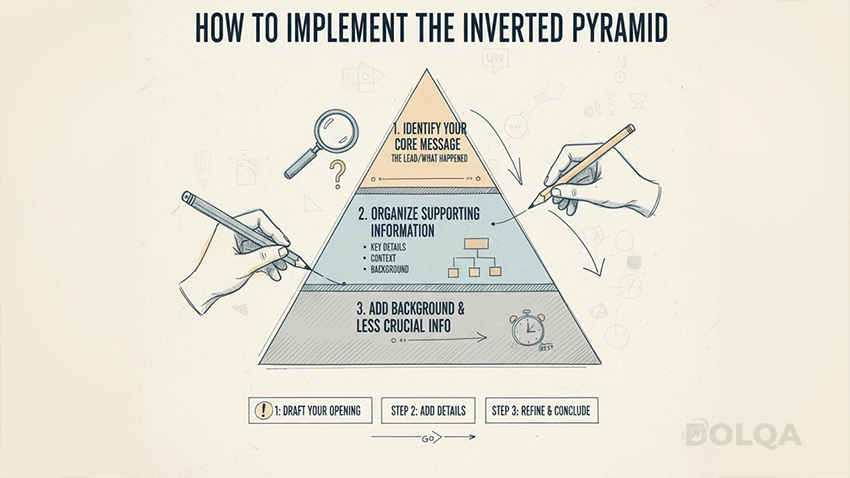Introduction
Have you ever wondered why some web content immediately grabs your attention while other articles lose you after the first paragraph? The secret lies in a time-tested writing technique called inverted pyramid writing. Originally developed by journalists over a century ago, this powerful content structure method has become essential for digital journalism and modern web writing.
This guide will teach you how to implement the inverted pyramid technique to create compelling content that captures readers instantly, improves your search rankings, and dramatically boosts reader engagement.
What Is the Inverted Pyramid Technique?
The inverted pyramid is a writing structure that places your most critical information at the very beginning. Unlike traditional storytelling that builds to a climax, this method delivers the conclusion first, followed by supporting details, and ends with background information.
Picture an upside-down triangle: the widest part (top) contains your main message answering who, what, when, where, why, and how. The middle section includes important supporting details. The narrow bottom holds supplementary information and context.
Why This Structure Works for Digital Content
Online readers have notoriously short attention spans. Research shows that web users scan rather than read word-for-word. By front-loading your key message, you ensure that even scanners understand your content's value within seconds. This approach respects your reader's time while satisfying their immediate need for answers.
Key Benefits of Inverted Pyramid Writing
Enhances Reader Engagement
When you deliver value immediately, readers quickly determine whether your content matches their needs. This instant clarity keeps them on your page longer and reduces bounce rates. Your audience can stop reading at any point and still understand the core message.
Improves SEO Performance
Search engines prioritize clear, well-structured content. Using SEO writing techniques like the inverted pyramid naturally places your target keywords in prominent positions at the beginning of your content. This keyword prominence signals relevance to search algorithms, improving your rankings.
Supports Multiple Reading Styles
Some visitors thoroughly read every word, others skim headings, and many fall somewhere in between. The inverted pyramid accommodates all reading styles by making every section independently valuable. Each paragraph's first sentence introduces its key concept, allowing scanners to grasp your message efficiently.
How to Implement the Inverted Pyramid: Step-by-Step
Step 1: Identify Your Core Message
Before writing, determine your single most important point. What must readers remember if they read nothing else? This becomes your opening paragraph. Answer the fundamental questions immediately: who, what, when, where, why, and how.
Step 2: Organize Supporting Information
List all supporting details, facts, and data that reinforce your main message. Arrange these points in descending order of importance. The most critical supporting information goes directly after your opening, while less essential details appear further down.
Step 3: Structure with Clear Headings
Use descriptive subheadings (H2 and H3 tags) to organize your content into scannable sections. Each heading should communicate what information follows, helping readers navigate to sections relevant to their interests.
Step 4: Write Powerful Opening Sentences
Every paragraph should begin with a core sentence that presents the paragraph's main idea. This technique enables readers to scan first sentences and still comprehend your article's flow and key points.
Step 5: Add Background and Context
Place historical information, extended explanations, and tangential details toward the end. This positioning ensures essential information comes first while still providing depth for readers seeking comprehensive coverage.

Essential Tools and Resources
Content Management Systems
WordPress, Joomla, and similar platforms support inverted pyramid structure with features like excerpt fields and "read more" links. These tools help you implement summary-first presentations naturally.
SEO Analysis Tools
Yoast SEO and similar plugins analyze your content structure and keyword placement, helping you optimize for both readers and search engines. These tools often include readability scores that align with inverted pyramid principles.
Writing Style Guides
Reference "The Elements of Style" by William Strunk for timeless writing principles. This classic emphasizes concise, vigorous writing that eliminates unnecessary words—a perfect complement to inverted pyramid thinking.
When NOT to Use the Inverted Pyramid
While powerful for most web content, this technique isn't universal. Creative writing forms like poetry, fiction, and narrative essays often require different structures. Long-form investigative pieces that build suspense may benefit from alternative approaches.
Academic writing typically follows traditional structures with conclusions at the end. Case studies and in-depth analyses sometimes need to establish context before revealing findings. Evaluate your content's purpose and audience before committing to any single structure.
Practical Tips for Success
Write concisely: Every word should serve a purpose. Cut unnecessary phrases that dilute your message.
Use active voice: Direct, active sentences communicate more clearly than passive constructions.
Break up text: Short paragraphs, bullet points, and numbered lists improve scannability.
Test and revise: After writing, review paragraph order. Can you improve clarity by rearranging sections?
Front-load keywords: Naturally incorporate target keywords in your opening paragraphs without forced repetition.
Measuring Your Success
Track these metrics to evaluate how inverted pyramid writing improves your content performance:
- Time on page: Longer visit durations indicate engaging content
- Bounce rate: Lower percentages suggest readers find immediate value
- Scroll depth: Higher percentages show readers exploring beyond the opening
- Search rankings: Monitor keyword position improvements over time
- Click-through rates: Better-structured content often generates higher CTRs from search results
Conclusion
The inverted pyramid technique transforms how you approach web content creation. By prioritizing your reader's needs and delivering value immediately, you build trust, improve engagement, and enhance your search visibility. This method isn't just about structure—it's about respecting your audience's time and attention.
Start implementing these principles in your next article. Map out your key points, organize by importance, write clear opening sentences, and watch your content performance improve. What content will you transform using the inverted pyramid technique?
Share your experiences in the comments below or contact us for personalized content strategy guidance.







Comments (0)
Leave a Comment
No comments yet. Be the first to comment!